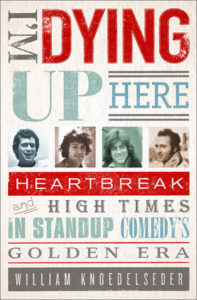I’m Dying Up Here – Review

This book is set in the period of the 1970s when there was the comedy gold rush which started in LA. Much of this rush was centred on The Comedy Store, located on Sunset Blvd, which was run by the wannabe benevolent dictator, Mitzi Shore. The book details how Mitzi found herself managing her then husband’s business venture and through a combination the luck of timing, having the unique vision to see that there was a real opportunity and hard work to push it through she ended up at the first comedy stand-up rooms that virtually all rooms nowadays replicate.
The book starts with a contemporary scene, the death of a journey man comic, George Miller, in 2003. He never got huge, but was good enough to gig consistently from the 70s. His death brings back together some of the people who were peers of his time. There is serious name dropping, Richard Lewis, Jay Leno, Dave Letterman. At the start one gets the feeling this is just to add sizzle to the steak. However, after the opening chapter, the story falls back to the beginning. It is here you begin to realise that this is actually where all these names got their start, their real start. Mitizi recognised and groomed the talent that arrived at her room and competed with each other to get stage time. No one disagrees with the fact that she had an excellent eye for comics that would go far.
The first half of the book details all the fun and games of being a comic in the 70s. There is of course sex, drugs and rock and roll. It is all fun, but they don’t dwell too much on that part of the scene as ultimately it is not that important to the story. Comedy for some was a job, and to keep doing it they needed to graduate to paying gigs. Anybody that wants to be successful always had their eye on “The Carson Spot”. The 5 minute routine on Johnny Carson’s The Tonight Show. Make it here and doors open. Some get on and it launches their career, a small portion are still in the business all these years later, others get on, but they run a bit flat, maybe they had a bad night. It would be passed back that maybe they weren’t ready. Almost if one had “The Right Stuff” or was a flaming crater in the desert.
The second half of the book changes gears and slows down in some respects. Due to an emergent art having so few benefactors, Mitzi has landed an arrangement where the bulk of the performers don’t get paid to perform. She has convinced them, and sometimes I wonder herself, that she is providing a service to the comics to learn their art and use her room as a showcase to get paying gigs elsewhere. Her room is the first and only comedy university. This seems to play for a while. When the comedy tsunami arrives, first in LA and then the United States, she is riding the crest of it, she literally can make and break anybody and is pocketting all of the proceeds. Comics begin to see the disparity of packed out rooms, full bar services and being unable to buy their own breakfast the very next day. This leads to the first comedy strike, a picket line is put up around the club and friendships are tested and in some cases destroyed, forever! The remainder of the book details the strike and the complexities of that nascent world and how it gave birth to the standup format we see world wide today.
During this time we see Jay Leno, David Letterman, Robin Williams, Andy Kaufman all rotate in and out of the story. As the story unfolds it becomes clear that the Comedy Store is very influential on them and the careers they end up having. Jay Leno is actually an integral part of the strike. Letterman is also present, but his own career is starting to take off at the same time. The author mentions the falling out they had later in their careers when it came to Leno successfully replacing Carson when he retired from the Tonight Show in 1991, even though Letterman was groomed as Carson’s replacement. No reason is offered, only a description of how the two had been close friends before either was famous, which provides a context to why some might perceive what Leno did to Letterman as a betrayal.
It is a fun and informative book. It lays out the history and the world of the comedy scene as it was being born from nothing in LA and largely in Mitzi’s Comedy Store. Knoedelseder has done his homework, he was physically present attending and reviewing comedy during the period in question. It is refreshing to go back and see the formation of a world that has become so ubiquitous since then, even though we also get to see it turn from it youthful beginnings to the corporate facade we now see today.
I always was amused by this piece by Bill Hicks, now it has a little more nuance:
